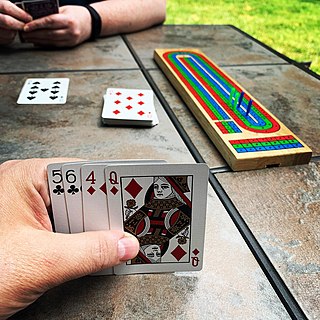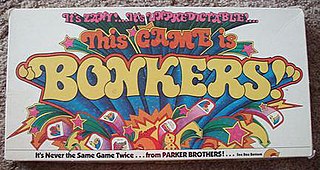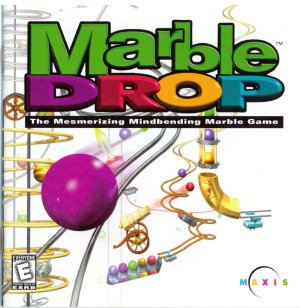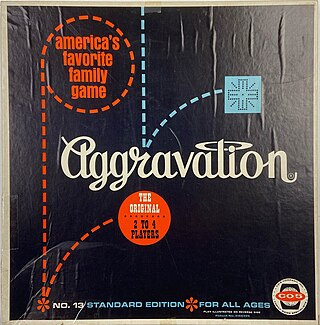
Cribbage, or crib, is a card game, traditionally for two players, that involves playing and grouping cards in combinations which gain points. It can be adapted for three or four players.

Sorry! is a board game that is based, like the older game Ludo, on the ancient Indian cross and circle game Pachisi. Players move their three or four pieces around the board, attempting to get all of their pieces "home" before any other player. Originally manufactured by W.H. Storey & Co in England and now by Hasbro, Sorry! is marketed for two to four players, ages 6 and up. The game title comes from the many ways in which a player can negate the progress of another, while issuing an apologetic "Sorry!"

ZÈRTZ is the third game in the GIPF Project of seven abstract strategy games. The game features a shrinking board and an object that promotes sacrifice combinations. It is impartial: since neither player owns on-board pieces, maintaining the initiative is of fundamental importance.

Cosmic Encounter is a science fiction–themed strategy board game designed by "Future Pastimes" and originally published by Eon Games in 1977. In it, each player takes the role of a particular alien species, each with a unique power to bend or break one of the rules of the game, trying to establish control over the universe. The game was inducted into the Academy of Adventure Gaming Arts & Design Adventure Gaming Hall of Fame in 1997.

A marble is a small spherical object often made from glass, clay, steel, plastic, or agate. These toys can be used for a variety of games called marbles, as well being placed in marble runs or races, or created as a form of art. They are often collected, both for nostalgia and for their aesthetic colors.

Alhambra is a 2003 tile-based German-style board game designed by Dirk Henn. It was originally published in Germany by Queen Games in a language-interdependent version; an English-specific version was released in North America by the now-defunct Überplay. The game is a Muslim-themed update, set during the construction of the Alhambra palace in 14th century Granada, of the 1998 stock trading board game Stimmt So!, which in turn was an update of the 1992 mafia influence board game Al Capone; the original version was subsequently released as Alhambra: The Card Game. Upon its release, Alhambra won numerous awards, including the Spiel des Jahres award. Its success has led to the release of numerous expansion packs and spin-off games, and is becoming Queen Games' flagship franchise.

B-Daman is a marble shooting toy franchise produced in Japan by Takara. It was originally based on the Bomberman series, but later expanded into other franchises and its own original designs.

Hecatomb is an out-of-print collectible card game created by Wizards of the Coast. The base set of 144 cards was released on August 18, 2005 at the annual Gen Con Indy. The game is unique in its use of five-sided, stackable cards made of durable plastic as opposed to conventional paperboard. The original concept for the game is credited to Paul Barclay, Brandon Bozzi, Mike Elliott, Aaron Forsythe, and Robert Gutschera.

Bonkers! is a race-style board game designed by Paul J. Gruen and produced first by Parker Brothers, later by Milton Bradley, and briefly reissued by Winning Moves. The object is to be the first player to score 12 points by adding instruction cards to the empty spaces in an attempt to move to several scoring stations. The game's slogan is "It's Never the Same Game Twice!"

Tock is a board game, similar to Ludo, Aggravation or Sorry!, in which players race their four tokens around the game board from start to finish—the objective being to be the first to take all of one's tokens "home". Like Sorry!, it is played with playing cards rather than dice.

Marble Drop is a puzzle video game published by Maxis on February 28, 1997.

Wahoo is a cross and circle board game similar to Parchisi that involves moving a set number of marbles around the board, trying to get them into the safety zone. The game is alleged to have originated in the Appalachian hills, but it is nearly identical to Mensch Ärgere Dich Nicht, a German board game originating in 1907. Most boards are used by two to four players. Wahoo has been a popular game for decades. Even today, custom-made boards proliferate on eBay and game manufacturer Parker Brothers has sold their own version of the game, under the title Aggravation, for decades.

Aggravation is a board game for up to four players and later versions for up to six players, whose object is to be the first player to have all four playing pieces reach the player's home section of the board. The game's name comes from the action of capturing an opponent's piece by landing on its space, which is known as "aggravating". The name was coined by one of the creators, Louis Elaine, who did not always enjoy defeat.

Pyramid is a drinking game played with a standard deck of playing cards.

Four-field kono is an abstract strategy game from Korea. Each player attempts to capture the other player's pieces by jumping over their own piece and landing on the other player's piece. The game is not related or similar to another Korean game called five-field kono.

Qwirkle is a tile-based game for two to four players, designed by Susan McKinley Ross and published by MindWare in 2006. Qwirkle shares some characteristics with the games Rummikub and Scrabble. It is distributed in Canada by game and puzzle company Outset Media. Qwirkle is considered by MindWare to be its most awarded game of all time. In 2011, Qwirkle won the Spiel des Jahres. A sequel, Qwirkle Cubes, was released by Mindware in 2009.
The following is a glossary of poker terms used in the card game of poker. It supplements the glossary of card game terms. Besides the terms listed here, there are thousands of common and uncommon poker slang terms. This is not intended to be a formal dictionary; precise usage details and multiple closely related senses are omitted here in favor of concise treatment of the basics.

RoboRally, also stylized as Robo Rally, is a board game for 2–8 players designed by Richard Garfield and published by Wizards of the Coast (WotC) in 1994. Various expansions and revisions have been published by WotC, Avalon Hill, and Renegade Games.

Forbidden Desert is a cooperative board game developed by Matt Leacock and published by Gamewright Games. It is a sequel to the game Forbidden Island. It is also available on mobile.

Uno Flip! is an American shedding-type card game produced by Mattel. The cards from the deck are specially printed for the game. This game is a variation of Uno.

























